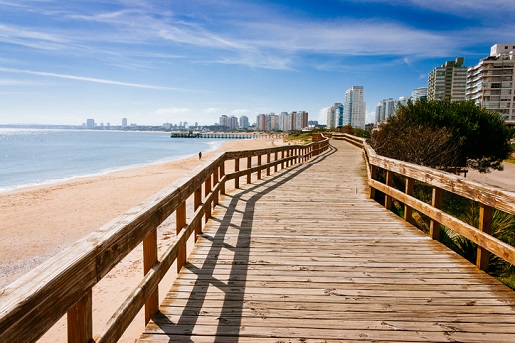How to Obtain an Uruguay Retirement Visa

Uruguay continues to attract foreign retirees drawn to its safe and secure economy, moderate climate, and highly-developed infrastructure. About 90 percent of its population is European (largely Spanish and Italian), creating a culture with strong European characteristics. International Living magazine ranks Uruguay among its top 10 global retirement destinations, stating “The country is less well-known than many other destinations in Latin America; however, it is a particularly attractive option for people considering where to retire in Latin America.” Uruguay’s bustling modern cities, beachfront cottages, and quiet farms provide retirees with plenty of options.
In 2019, more than three million tourists visited the Oriental Republic of Uruguay before the COVID-19 pandemic halted foreign travel. By 2022, the country had dropped coronavirus testing requirements and travelers began returning. It takes about 12 hours to fly from Atlanta to the capital city of Montevideo on the country’s southern Atlantic coast (with one stop in Panama City, Panama on Copa Airlines or one stop in Santiago, Chile on Delta Airlines and LATAM Airlines).
Living costs in Uruguay are not as low as most other Latin American countries, which can be attributed to its status as one of the most prosperous, politically stable, and well-developed nations in South America. Living costs average almost 15% lower than those in the United States, while rents are 68% less, according to Numbeo (https://www.numbeo.com/cost-of-living/country_result.jsp?country=Uruguay). Retirees are also attracted to Uruguay’s low taxes, affordable healthcare system, and low crime rates. While Spanish is the most common language spoken in Uruguay, English is commonly spoken among younger generations, business people, and residents of major cities.
Montevideo, the largest city in Uruguay, ranks among the most popular destinations for expats and retirees. Two-thirds of Montevideo’s residents are of Italian descent, giving the city a unique blend of Spanish and Italian architecture and culture. The Rambla, a 13-mile coastal walkway popular with walkers, runners, and bikers. Foreigners also favor the Picitos area, home to two shopping malls and more than 100 restaurants. The capital city is also a short ferry ride across Montevideo Bay from Buenos Aires, Argentina, the most visited city in South America. The top beach resort in Uruguay is Punta del Este, a jet-setters’ hotspot where Gorlero Street leads to restaurants, clubs and the main plaza. In nearby Moldonado, many retirees live in the Pinarea neighborhood, or on farms and country estates surrounding the city. Another popular coastal retirement destination is La Paloma, a less well-developed and lower-cost town with sandy grey beaches on the Atlantic. Beaches and other tourist attractions are busiest during the Southern Hemisphere summer months of January and February.
Uruguay also contains nearly a dozen national parks and three UNESCO World Heritage sites. The newest UNESCO site is the unique brick Cristo Obrero Church in Atlántida, designated in 2021. The other two sites are the Historic Quarter of Colonia Del Sacramento, one of the country’s oldest towns; and the river port city of Fray Bentos. Popular beach destinations include upscale Playa de los Pocitos near Montevideo; Piriápolis, a favorite of surfers and history lovers; and the longest beach in the country, 45-kilometer Costa de Oro. The village of Punta del Diablo (Devil's Point) attracts hikers to its sand dunes and the forested seaside reserve of Santa Teresa National Park. Other popular attractions include carnival season in Montevideo, street tango dancing in the streets, the sea lions of Cabo Polonio, whale-spotting along the Atlantic Coast, Fortress General Artigas, the hot springs of Dayman, and Uruguay's first water park, Acuamania.
Uruguay Retirement Visa Programs
Uruguay has lifted most of its travel restrictions related to COVID-19 and has fully reopened its borders to fully vaccinated non-resident foreigners, making it easier to visit the country. Citizens of the United States and most other countries do not need a visa to visit Uruguay unless they plan to stay for more than 180 days. Upon arrival, travelers are be issued a temporary 90-day visa, which can be extended for another 90 days by paying an additional fee. If you want to stay longer, you must obtain a visa.
There are two basic residency options for foreigners to live in Uruguay: permanent and temporary. The temporary residency or work visa typically covers people employed in specific industries for up to four years. Uruguay has several permanent residency visas, including the rentista (resident) available for people with a fixed income. Retirees who receive at least $1,500 in monthly income typically choose the pensioner (pensionado) visa. Similar to the rentista, the retirement visa allows you to obtain residency immediately upon approval and lets you bring your personal vehicle to Uruguay duty-free.
After living in Uruguay on the retirement visa and spending most of your time in the country, you can apply for a Uruguayan passport and/or citizenship. Married couples can apply after three years of residency, while single foreigners must wait five years. Uruguay allows dual citizenship, so you are not required to renounce your U.S. citizenship.
How to Obtain a Retirement Visa
Unlike most other countries, you cannot begin the retirement visa process through an embassy or consulate in the United States, nor can you apply online. You will need to file your application in person at a government office in Montevideo after you arrive. However, you can obtain more information from the embassy website (https://embassyofuruguay.us), or by contacting one of their consulates in Miami, New York, San Francisco, and Washington, D.C.
You will need to gather all the required documents for your retirement visa and bring them with you when you enter Uruguay. Documents will also need to be translated into Spanish by an official Uruguayan public translator upon arrival.
Required documentation for the pensioner visa includes:
- Original U.S. passport plus a copy of your passport.
- Passport-size photo.
- Birth certificate.*
- Marriage certificate.*
- Documentation from police in your home country that you have no criminal record for the prior five years. The document must have been issued within the last six months.*
- Proof of at least $1,500 monthly pension income from your home country, prepared by a CPA or other financial professional. Your pension must also be paid into a Uruguayan bank. Your statement of income will need to be certified by a notary public in Uruguay.
- Vaccination records. Adults must have had a current tetanus shot and an MMR vaccine; if not, you can receive your shots at a hospital after arrival. Minors must meet the same vaccination criteria as other children in Uruguay: chickenpox, diphtheria, hepatitis A, hepatitis B (at age 12), Hib B vaccine, measles (at age five), pertussis (whooping cough), polio, PCV13, and tetanus.
- Health card, which you will obtain after arriving. The appointment takes about 15 minutes. You can get a health card free of charge from the state Ministerio de salud Publica, or pay $75 at a private clinic (where wait times are much lower).
- Entry/departure card showing when you entered the country.
*These documents must be apostilled (verified by a legal entity in the United States) and then confirmed by the Uruguayan consulate.
When you submit your application, you will be given an ID card that basically provides you the same benefits and privileges as other permanent residents. It generally takes six to 12 months for the government to process your retirement visa application.
U.S. citizens with questions about obtaining a retirement visa for Uruguay -- or who would like us to help ensure they have accumulated the necessary documents and paperwork before they travel to Uruguay -- can schedule a telephone call through our website.





